中西文化差异——中西死亡观对比
- 格式:docx
- 大小:36.73 KB
- 文档页数:9
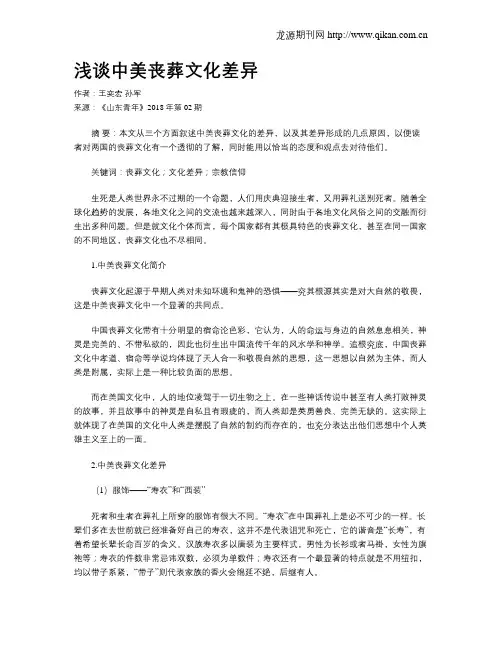
浅谈中美丧葬文化差异作者:王奕宏孙军来源:《山东青年》2018年第02期摘要:本文从三个方面叙述中美丧葬文化的差异,以及其差异形成的几点原因,以便读者对两国的丧葬文化有一个透彻的了解,同时能用以恰当的态度和观点去对待他们。
关键词:丧葬文化;文化差异;宗教信仰生死是人类世界永不过期的一个命题,人们用庆典迎接生者,又用葬礼送别死者。
随着全球化趋势的发展,各地文化之间的交流也越来越深入,同时由于各地文化风俗之间的交融而衍生出多种问题。
但是就文化个体而言,每个国家都有其极具特色的丧葬文化,甚至在同一国家的不同地区,丧葬文化也不尽相同。
1.中美丧葬文化简介丧葬文化起源于早期人类对未知环境和鬼神的恐惧——究其根源其实是对大自然的敬畏,这是中美丧葬文化中一个显著的共同点。
中国丧葬文化带有十分明显的宿命论色彩,它认为,人的命运与身边的自然息息相关,神灵是完美的、不带私欲的,因此也衍生出中国流传千年的风水学和神学。
追根究底,中国丧葬文化中孝道、宿命等学说均体现了天人合一和敬畏自然的思想,这一思想以自然为主体,而人类是附属,实际上是一种比较负面的思想。
而在美国文化中,人的地位凌驾于一切生物之上。
在一些神话传说中甚至有人类打败神灵的故事,并且故事中的神灵是自私且有瑕疵的,而人类却是英勇善良、完美无缺的。
这实际上就体现了在美国的文化中人类是摆脱了自然的制约而存在的,也充分表达出他们思想中个人英雄主义至上的一面。
2.中美丧葬文化差异(1)服饰——“寿衣”和“西装”死者和生者在葬礼上所穿的服饰有很大不同。
“寿衣”在中国葬礼上是必不可少的一样。
长辈们多在去世前就已经准备好自己的寿衣,这并不是代表诅咒和死亡,它的谐音是“长寿”,有着希望长辈长命百岁的含义。
汉族寿衣多以唐装为主要样式,男性为长衫或者马褂,女性为旗袍等;寿衣的件数非常忌讳双数,必须为单数件;寿衣还有一个最显著的特点就是不用纽扣,均以带子系紧,“带子”则代表家族的香火会绵延不绝,后继有人。
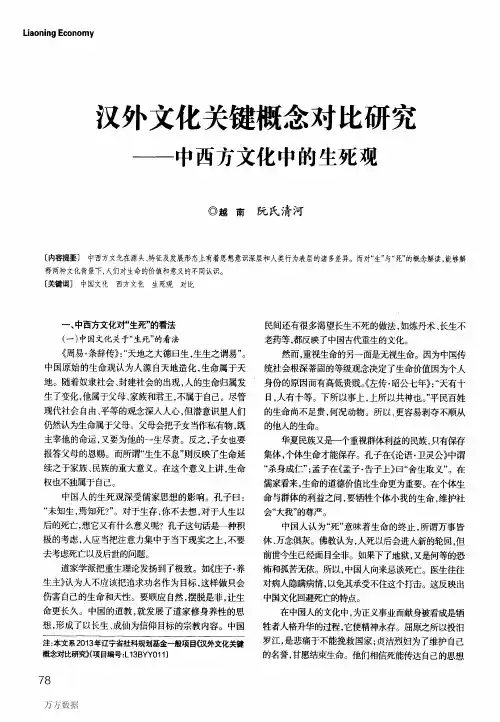
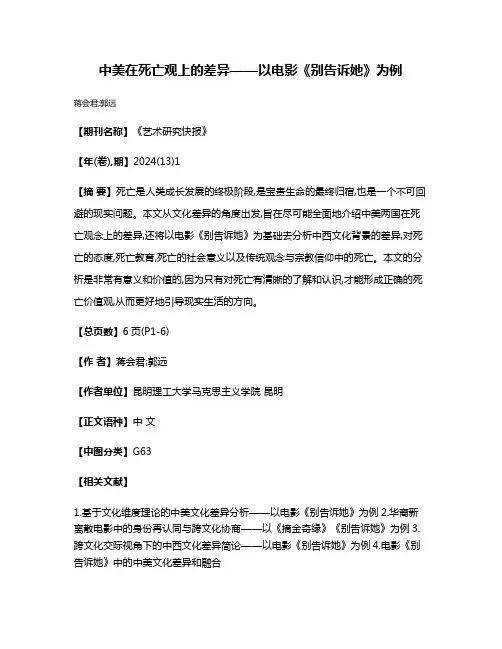
中美在死亡观上的差异——以电影《别告诉她》为例
蒋会君;郭远
【期刊名称】《艺术研究快报》
【年(卷),期】2024(13)1
【摘要】死亡是人类成长发展的终极阶段,是宝贵生命的最终归宿,也是一个不可回避的现实问题。
本文从文化差异的角度出发,旨在尽可能全面地介绍中美两国在死亡观念上的差异,还将以电影《别告诉她》为基础去分析中西文化背景的差异,对死亡的态度,死亡教育,死亡的社会意义以及传统观念与宗教信仰中的死亡。
本文的分析是非常有意义和价值的,因为只有对死亡有清晰的了解和认识,才能形成正确的死亡价值观,从而更好地引导现实生活的方向。
【总页数】6页(P1-6)
【作者】蒋会君;郭远
【作者单位】昆明理工大学马克思主义学院昆明
【正文语种】中文
【中图分类】G63
【相关文献】
1.基于文化维度理论的中美文化差异分析——以电影《别告诉她》为例
2.华裔新离散电影中的身份再认同与跨文化协商——以《摘金奇缘》《别告诉她》为例
3.跨文化交际视角下的中西文化差异简论——以电影《别告诉她》为例
4.电影《别告诉她》中的中美文化差异和融合
因版权原因,仅展示原文概要,查看原文内容请购买。
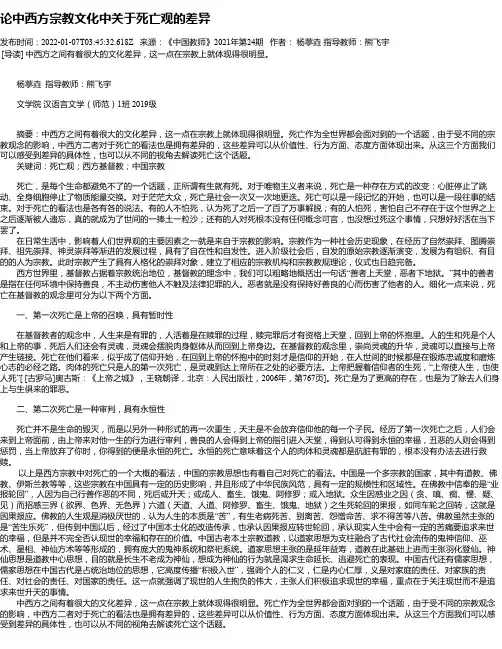
论中西方宗教文化中关于死亡观的差异发布时间:2022-01-07T03:45:32.618Z 来源:《中国教师》2021年第24期作者:杨葶垚指导教师:熊飞宇[导读] 中西方之间有着很大的文化差异,这一点在宗教上就体现得很明显。
杨葶垚指导教师:熊飞宇文学院汉语言文学(师范)1班 2019级摘要:中西方之间有着很大的文化差异,这一点在宗教上就体现得很明显。
死亡作为全世界都会面对到的一个话题,由于受不同的宗教观念的影响,中西方二者对于死亡的看法也是拥有差异的,这些差异可以从价值性、行为方面、态度方面体现出来。
从这三个方面我们可以感受到差异的具体性,也可以从不同的视角去解读死亡这个话题。
关键词:死亡观;西方基督教;中国宗教死亡,是每个生命都避免不了的一个话题,正所谓有生就有死。
对于唯物主义者来说,死亡是一种存在方式的改变:心脏停止了跳动、全身细胞停止了物质能量交换。
对于茫茫大众,死亡是社会一次又一次地更迭。
死亡可以是一段记忆的开始,也可以是一段往事的结束。
对于死亡的看法也是各有各的说法。
有的人不怕死,认为死了之后一了百了万事解脱;有的人怕死,害怕自己不存在于这个世界之上之后逐渐被人遗忘,真的就成为了世间的一捧土一粒沙;还有的人对死根本没有任何概念可言,也没想过死这个事情,只想好好活在当下罢了。
在日常生活中,影响着人们世界观的主要因素之一就是来自于宗教的影响。
宗教作为一种社会历史现象,在经历了自然崇拜、图腾崇拜、祖先崇拜、神灵崇拜等渐进的发展过程,具有了自在性和自发性。
进入阶级社会后,自发的原始宗教逐渐演变,发展为有组织、有目的的人为宗教。
此时宗教产生了具有人格化的崇拜对象,建立了相应的宗教机构和宗教教规理论,仪式也日趋完备。
西方世界里,基督教占据着宗教统治地位,基督教的理念中,我们可以粗略地概括出一句话“善者上天堂,恶者下地狱。
”其中的善者是指在任何环境中保持善良,不主动伤害他人不触及法律犯罪的人。
恶者就是没有保持好善良的心而伤害了他者的人。
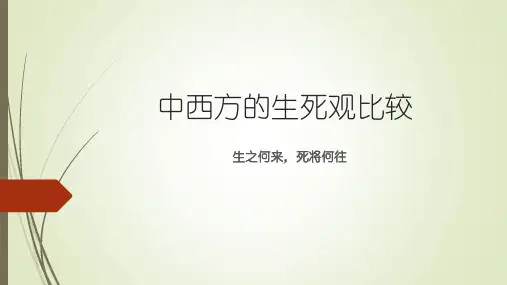
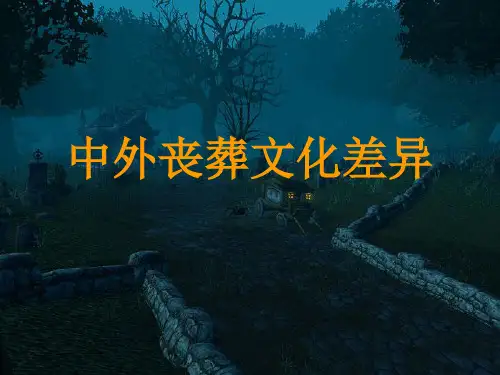
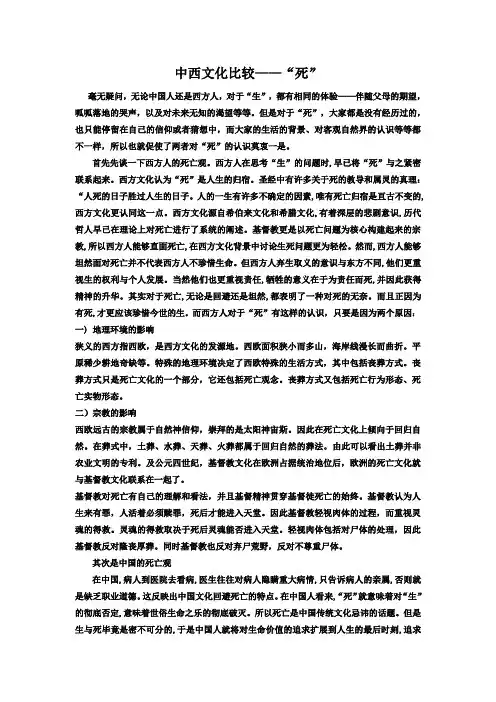
中西文化比较——“死”毫无疑问,无论中国人还是西方人,对于“生”,都有相同的体验——伴随父母的期望,呱呱落地的哭声,以及对未来无知的渴望等等。
但是对于“死”,大家都是没有经历过的,也只能停留在自己的信仰或者猜想中,而大家的生活的背景、对客观自然界的认识等等都不一样,所以也就促使了两者对“死”的认识莫衷一是。
首先先谈一下西方人的死亡观。
西方人在思考“生”的问题时,早已将“死”与之紧密联系起来。
西方文化认为“死”是人生的归宿。
圣经中有许多关于死的教导和属灵的真理:“人死的日子胜过人生的日子。
人的一生有许多不确定的因素,唯有死亡归宿是亘古不变的,西方文化更认同这一点。
西方文化源自希伯来文化和希腊文化,有着深层的悲剧意识,历代哲人早已在理论上对死亡进行了系统的阐述。
基督教更是以死亡问题为核心构建起来的宗教,所以西方人能够直面死亡,在西方文化背景中讨论生死问题更为轻松。
然而,西方人能够坦然面对死亡并不代表西方人不珍惜生命。
但西方人弃生取义的意识与东方不同,他们更重视生的权利与个人发展。
当然他们也更重视责任,牺牲的意义在于为责任而死,并因此获得精神的升华。
其实对于死亡,无论是回避还是坦然,都表明了一种对死的无奈。
而且正因为有死,才更应该珍惜今世的生。
而西方人对于“死”有这样的认识,只要是因为两个原因:一) 地理环境的影响狭义的西方指西欧,是西方文化的发源地。
西欧面积狭小而多山,海岸线漫长而曲折。
平原稀少耕地奇缺等。
特殊的地理环境决定了西欧特殊的生活方式,其中包括丧葬方式。
丧葬方式只是死亡文化的一个部分,它还包括死亡观念。
丧葬方式又包括死亡行为形态、死亡实物形态。
二)宗教的影响西欧远古的宗教属于自然神信仰,崇拜的是太阳神宙斯。
因此在死亡文化上倾向于回归自然。
在葬式中,土葬、水葬、天葬、火葬都属于回归自然的葬法。
由此可以看出土葬并非农业文明的专利。
及公元四世纪,基督教文化在欧洲占据统治地位后,欧洲的死亡文化就与基督教文化联系在一起了。

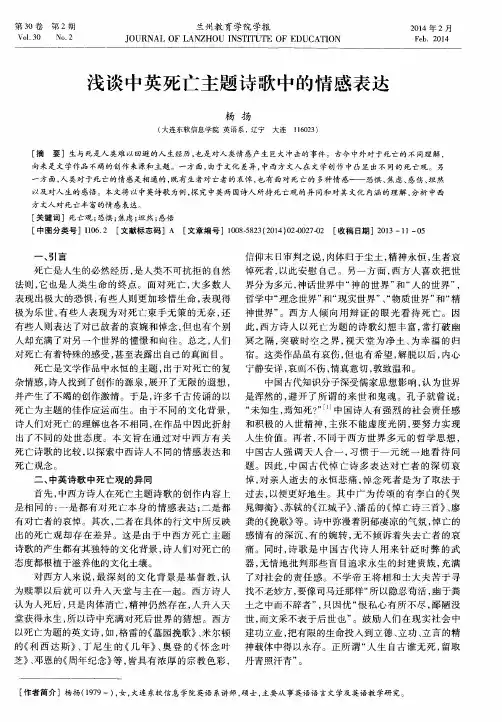
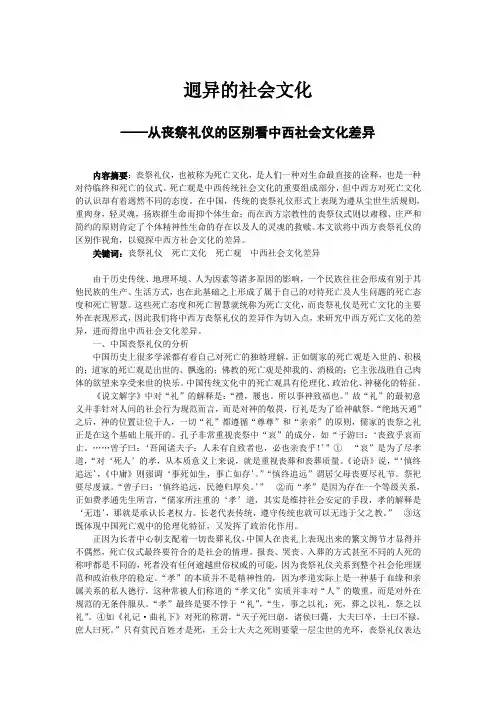
迥异的社会文化——从丧祭礼仪的区别看中西社会文化差异内容摘要:丧祭礼仪,也被称为死亡文化,是人们一种对生命最直接的诠释,也是一种对待临终和死亡的仪式。
死亡观是中西传统社会文化的重要组成部分,但中西方对死亡文化的认识却有着迥然不同的态度。
在中国,传统的丧祭礼仪形式上表现为遵从尘世生活规则,重肉身,轻灵魂,扬族群生命而抑个体生命;而在西方宗教性的丧祭仪式则以肃穆、庄严和简约的原则肯定了个体精神性生命的存在以及人的灵魂的救赎。
本文欲将中西方丧祭礼仪的区别作视角,以窥探中西方社会文化的差异。
关键词:丧祭礼仪死亡文化死亡观中西社会文化差异由于历史传统、地理环境、人为因素等诸多原因的影响,一个民族往往会形成有别于其他民族的生产、生活方式,也在此基础之上形成了属于自己的对待死亡及人生问题的死亡态度和死亡智慧。
这些死亡态度和死亡智慧就统称为死亡文化,而丧祭礼仪是死亡文化的主要外在表现形式,因此我们将中西方丧祭礼仪的差异作为切入点,来研究中西方死亡文化的差异,进而得出中西社会文化差异。
一、中国丧祭礼仪的分析中国历史上很多学派都有着自己对死亡的独特理解,正如儒家的死亡观是入世的、积极的;道家的死亡观是出世的、飘逸的;佛教的死亡观是抑我的、消极的;它主张战胜自己肉体的欲望来享受来世的快乐。
中国传统文化中的死亡观具有伦理化、政治化、神秘化的特征。
《说文解字》中对“礼”的解释是:“禮,履也。
所以事神致福也。
”故“礼”的最初意义并非针对人间的社会行为规范而言,而是对神的敬畏,行礼是为了给神献祭。
“绝地天通”之后,神的位置让位于人,一切“礼”都遵循“尊尊”和“亲亲”的原则,儒家的丧祭之礼正是在这个基础上展开的。
孔子非常重视丧祭中“哀”的成分,如“子游曰:‘丧致乎哀而止。
……曾子曰:‘吾闻诸夫子:人未有自致者也,必也亲丧乎!’”①“哀”是为了尽孝道,“对‘死人’的孝,从本质意义上来说,就是重视丧葬和丧葬质量。
《论语》说,“‘慎终追远’,《中庸》则强调‘事死如生,事亡如存’。

此岸,彼岸-中西生死观比较此岸,彼岸是中西文化中关于生死观的一个重要比较点。
在中文中,“此岸”指的是人生的现世,而“彼岸”指的则是来世或者说是死后的世界;而在西方文化中,“此岸”也指的是人生的现世,但是“彼岸”则是指的天堂或地狱等死后的世界。
这种差异意义的存在主要得益于中西方文化背景下的宗教信仰和哲学思想的不同。
从历史上看,中西方文化对生死观的看法有着明显的区别。
在中国古代哲学思想中,人们总是将现世和来世作一个完整的体系,在此世间中不会放弃追求精神和身体的健康,更注重的是如何在今生行善积德,以期得到来生的回报。
而西方文化中,开始的时候是有比较明显的生死分界线的,那就是天堂和地狱。
它是通过宗教来解释生死两方面的事情,并将人的行为和行善与得到神的奖赏联系在一起,也就是落实到来生的命运上。
虽然存在差异,但是在中西方文化的生死观上也有一定的共通之处。
比如都认为,生命可以超越死亡。
在中文中,通过修道和身心修炼,人们可以达到永生的境界;在西方文化中,教义认为,灵魂是不会死亡的,只有肉体死亡但灵魂仍旧存活。
并且,在中西方文化中,人们都坚信,死后的生命是新的开始,是与世俗生活完全不同的境界。
此岸彼岸的中西异同,也通过影响人们生死观的价值和方式这一方面得到了体现。
在中文中,人们更注重于现世,认为人活在当下,应该全力以赴地生活好当前的日子。
他们相信,只有与世俗生活和谐共处,才能为来世的目的服务。
在西方文化中,人们更关注死后的结局,追求永恒的生命和幸福。
因此,他们更注重人的心灵世界,更加重视精神修养。
从价值观上来讲,中文中的“此岸”更意味着“现世”的珍爱,禅宗是寻求平静、解脱和真正的自我,道教是通过道德修养去显性地寻找长存的安稳;而西方文化中的“彼岸”则是对死亡的想象,是对永生、恶魔、天堂等精神世界的追求,象征着不可见的境地、未知的领域或将来的状态。
两种生死观念都存在着渴望,但元素、立场和手段不同。
总之,此岸彼岸是中西文化中关于生死观的一个重要比较点。
从丧葬看中西方文化差异摘要:中西方文化在宗教、伦理、颜色、礼物等方面存在明显差异,究其根源,中华文化一直没有摆脱人对自然的依附关系,西方文化则是彻底摆脱了人对自然的依属。
关键词:丧葬文化中西文化差异不言而喻,每一个民族身上都带有自己的文化,中西方两种自成系统的文化传统充分体现了中西方民族的文化差异。
中西文化虽然经过数百年的冲突和交融,各自的界限已经不是特别明显,但无论中方还是西方文化的主导地位还是自身文化脉系的传承,还具有明显的文化差异。
从中美传统的丧葬礼仪之中,我们可以明显地感觉到这一差异。
一、丧葬中的中西文化差异1、宗教文化不同。
在丧葬中,西方国家基本上属于宗教式的丧葬礼仪。
西方丧葬礼俗主要受基督教文化的影响。
基督教将每一个人的灵魂直接与上帝发生关系,不允许偶像崇拜,崇尚灵魂升华而轻视肉体,因此西方的丧葬风俗是简丧薄葬。
基督教的丧礼更多的是为死者祈祷,祝其灵魂早日升入天堂,解脱生前痛苦。
近现代以来,由于西方崇尚“个人本位”,主张“以个人为中心”,因此在丧礼中,根据宗教礼仪,重在安置死者的“灵魂”。
从它的丧葬仪式可以看到他们的宗教传统。
儒家确立了中国丧葬礼仪的大传统。
在传统中国文化中,一直存在灵魂不死的信仰,经儒家伦理化解释,人们关心死者的灵魂,灵魂附于神灵,供奉于祖庙。
后来佛教的传入,则带来了“六道轮回,转世托生”等观念。
道教是中国本土宗教,早期道家只讲炼丹成仙,在民间并无多大影响,但在发展过程中,它逐渐吸收了儒、佛教的许多观念,终于和儒、佛成为鼎足之势。
从道教对中国传统丧葬礼仪的影响中,亦可看到道教与儒、佛二教的关系,道教给丧葬文化带来了关于地府阴间的观念。
宗教的融合体现在丧葬礼仪中,那便是以儒家传统丧礼为主体,融合了佛、道二教的丧葬礼仪的出现。
明代小说《金瓶梅》中所描绘的李瓶儿葬礼是一个典型的个案。
其基本程序是儒家的,如装敛、报丧、成服、大敛、出殡等等;但其中又杂以众多佛、道习俗,如请阴阳生批书、置七星板、钉长命钉等是道教习俗;而念倒头经、做七七斋则是佛教习俗。
中西方对生死观的差异
中西方文化对生死观存在一些差异。
在中西方文化传统中,对生死的看法和态度有所不同。
在中国传统文化中,人们普遍持有生死有命的观念,认为生死是一种自然规律,人们无法改变。
因此,在面临死亡时,中国人通常比较接受,甚至带着一种宿命感。
此外,中国文化强调传统的家族观念,人们认为死后对家族的贡献和尊严是重要的。
而在西方文化中,人们更加强调个人的自由和独立。
西方传统认为个人对生死有更多的掌控权,并倾向于寻求延长寿命和改善生活质量的方法。
因此,西方人在面临死亡时,通常会采取更多的积极措施来延长生命,并对死亡持有更强烈的恐惧和抗拒。
此外,在宗教信仰方面,中西方文化也存在差异。
在中国,佛教、道教等宗教对生死有着深刻的哲学思考,较为关注来世,认为死亡并不是人生的终点,而是一种转变和再生。
而在西方,基督教等宗教常常强调来世的奖赏或惩罚,对存在与灵魂有一定的解释和期望。
总的来说,中西方文化对生死观存在一些差异。
中方文化注重宿命和家族观念,认为生死是自然的规律,而西方文化则更加注重个人掌控和积极延长生命。
宗教信仰也对生死观产生了影响。
从文化视角对比分析中西方丧葬习俗差异摘要:由于中西方的历史、地理、文化背景、宗教信仰和哲学流派等方面的不同,丧葬礼仪的形式以及理解也存在很大的差异,这从不同层次上折射出中西方生死观的不同。
因为丧葬仪式是根据一个地区或是民族的宗教信仰以及居民的价值观、生死观举行的,所以在不同地区就会有不同的传统丧葬仪式。
葬礼是对逝者祭奠的一种形式,从中西方葬礼的主色调、丧葬用品、葬礼中的哭泣等方面进行剖析,介绍中西方葬礼的不同,比较现今中西方的葬礼存在的显著差异,探讨影响中西方葬礼习俗的根本原因。
本文以对比我国与西方国家的人们对待丧葬的态度、处理方式、对死者缅怀形式以及丧葬仪式的不同,对中西方文化的生死观进行探讨。
关键词:文化、丧葬、习俗出生和死亡是每条生命必经的道路。
死亡是必然又神秘的人生过程的终点,而葬礼便是对安葬死亡的人以及死亡本身的礼节仪式。
从医学角度,死亡是心肺功能的丧失,心脏、呼吸系统或者脑功能停止运作。
人的生命是一个由出生、成长、衰老、死亡组成的连续过程,作为自然现象和社会现象,死亡在人类发展史上呈现着生命的二重性。
我国历来有重生悲死的传统,人们对死亡讳莫如深,远而避之,不敢谈论死亡。
为了避免死亡带来的恐惧感,表示对死亡的膜拜,“死亡”这一词汇被用意义相同或相近的词语代替。
现代汉语书面语用“去世”“过世”“仙世”“辞世”“安息”代替“死亡”,口语中用“去了”“走了”“不在了”“老了”代替“死亡”委婉说法。
对于“死亡”的禁忌,自古以来,人们对死亡有着畏惧甚至崇拜的心理,带有一种敬畏之情。
由于中西文化、宗教信仰和哲学流派等方面的不同,对丧葬礼仪的形式以及理解存在很大的差异,这也从不同层次上折射出中西方对生死观的不同。
一、中西方葬礼的理念差异西方宗教是对上帝的敬畏,中国则更加注重忠孝,这是以人为本的思想。
我们对于死亡是乐观面对的,认为生命的意义在于它的社会价值,生者只有在追求自己的社会价值的过程中,才能显现出生命存在的意义。
此岸,彼岸-中西生死观比较生死是人类最为关键的问题之一,不同的文化和宗教对于生死有着不同的观念。
而中西方的生死观也存在着一些差异。
本文将从不同的角度比较中西方生死观。
中西方生死观的根本差别在于宗教信仰。
在中国文化中,道教和佛教对生死有着深刻的解释和理解。
道教强调人的灵魂是不朽的,死后会转世投胎。
佛教则认为生死是一个无尽的轮回,人的死亡只是一个过程,灵魂会转世来世。
相比之下,基督教强调人的灵魂会在死后得到永恒的救赎,如果人相信基督并接受救赎,就能进入天堂。
这种观念与中西方的文化背景和宗教信仰有密切关系。
中西方的文化背景也影响了人们对待生死的态度。
在中国文化中,人们对生死比较感性和内敛,往往将死亡视为生命的终结,注重对生命的珍惜和追思。
而在西方文化中,人们对待生死比较积极和开放,将死亡视为生命的一部分,注重在生命中实现自己的理想和意义。
中西方社会对待生死的方式也有所不同。
在中国,人们对死亡比较厌恶和恐惧,通常避免谈论和接触死亡。
而在西方文化中,人们更加接受和理解死亡,普遍有一种“尽情生活,无悔而死”的态度。
中西方的医疗文化也对生死观产生了影响。
在中国,人们普遍接受中医和自然疗法,强调保持身体的平衡和健康。
而在西方,人们更加依赖现代医学和技术,在治疗疾病和延长寿命方面有更高的期望。
中西方的生死观存在着不同的差异。
中西方生死观的差异主要源于宗教信仰、文化背景、社会态度和医疗文化等方面的差异。
无论是中西方的生死观,都要求人们珍惜生命,对待死亡有一种积极和开放的态度。
生命是短暂的,我们应当珍惜每一个时刻,追求自己的理想和意义。
Comparison of the Thanatopsis in Western Civilizationand in Chinese CivilizationLV Guang-zhaoDepartment of Translation, School of Foreign Languages, DUT IntroductionAlong the journey of life, death is a seductive topic which does arouse our curiosity and the thirst for knowledge, yet it is tabooed in many cases [1]. In the classic movie The Seven Seals, when the Death asks the Knight whether he is ready to die, he answers: “My body is ready, but I am not.” Encountering the same question, most of the people perhaps answer the same, because we have no idea on what the death is. Who am I? Where am I going? We keep considering whether there is any other world after our deaths, however, only paradoxes and puzzles can be made, rather than results.In terms of the ultimate thinking of death, Epicurus said: “Death does not concern us”; Feuerbach said: “Death is the last reflection of life”; Confucius said: “Who has never understood the meaning of life, knows nothing about death”; Chuang-Tzu said: “Life and death are two different parts of destiny”. The thanatopsis is fundamentally built on the basis of culture and civilization, with the characteristic of mystery, religions and ethics, where exists regional, historical and cultural differences. This paper is comparing the thanatopsis in Western Civilization and in Chinese Civilization.Classical Period (Before 476AD in the west and 221BC in China)Classical Period saw an era of remarkable intellectual and cultural growth throughout the entire world. In the west, Greek world, especially Athens, became the motherland of democracy as well as the holy place of debate and philosophy. After the Romans came to their prosperity, the centre of thought was transferred into Rome, until the collapse of the Roman Empire. Nevertheless, the Greco-Roman civilization did establish the basis of western philosophy. In the east, the Emperor of Zhou Dynasty failed to build a powerful central administration, and the territory was actually governed by vassals who kept fighting against each other. Yet, it is in the political chaos that philosophers began to think and come out with ruling ideologies. Hundreds- 1 -of theories were promoted, including Confucianism and Taoism, which made the Spring and Autumn Period a heyday of Chinese intellectual history. Among the whole world, Classical Period was an era of political and military isolation as well as cultural and philosophical flourish.The first western thanatopsis dates back to over 2500 years ago. Thales, the founder of Miletus, put forward a theory on the basis of “Penta-rhei”[2], which means that every element is a cycle and that “water”is the foundation of the universe. He believed that everything is animate and souls are in a circle of life and death. Therefore, facing the death we need not to be afraid. In his theory, souls are perpetual, which influences the Europe for thousands of years. Socrates, however, did not agree with Thales on the cycle. In Plato’s Apology for Socrates, the great philosopher declared that “Only Gods know which one is better between life and death”. He believed that there are two situation after death—one is vacancy and the other is entering another world. In the first situation, death means nothing to people, just like sleeping, and in the latter situation, death means a new life in a world beyond our observation, both of which should not be afraid, because “Death could be better than life”[3]. In the following decades, his disciple Plato, one of the greatest philosophers in ancient Greece, further developed his ideas. He believed that “Death is a collapse of natural body”[4], which inherited the idea of Pythagoras. “Death is the soul of the immortal, which is released and enter the world of Ideas by leaving the restraint of natural body.[5]”According to Plato, Ideas are the perpetual yet invisible, and everything tangible in the world is the reflection of Ideas, which is named with “Theory of Ideas” [6]. In ancient European world, death was not a horrible or tabooed topic. Instead, highly-educated people to some extent looked forward to it, because it was commonly believed that people’s souls were immortal and perpetual. After the death, souls, which belong to the “world of Ideas”, would enter another world, which could be even better and brighter.Meanwhile, on the other side of the world, China was also seeing its heyday of thoughts. Confucianism, which is known as the Philosophy of Reasonableness, is the most influential one, and certain thanatopsis was shown in The Analects of Confucius. “Who has never understood the meaning of life, knows nothing about death”. Confucius believed that both life and death depend on the kismet. In The Book of Changes, Confucianism put forward a theory of Three Powers—the destiny, the ground and the spirit, and only the spirit can be controlled by people themselves. Therefore, death and what would happen after death are not such important, and what really matters is the attitude towards life, because death is something beyond people’scontrol. These theories were summarized and developed by Mencius with the concept of “transcendentalism” and “immanency”[7]. A certain demonstration was shown in The Book of Mencius: “One should not concentrate on the length of life, but on self-cultivation.” In Confucianism, the length of life is doomed and everyone is supposed to pursue the biggest value in the limited life, while Taoism avoided this paradox. According to Lao-Tzu, who established the school of Taoism, “All things take shape and become active, but I see them return to their source, like vegetation that grows and flourishes, b ut returns to the root from which it springs”, which reflected the essence of Taoist thanatopsis—falling leaves to their roots. In Lao-Tzu’s thanatopsis, the end and also the start point of everything in the world is “Tao”, which existed beyond the universe [8]. It is kind of similar with the cycle of Thales, but not exactly. Thales believed the universe consists of several basic elements, but in Taoism, “Tao”itself is everything, including the body and the soul. Thus, “Tao” can be regarded as the ultimate principle of both life and death. In ancient China, both Confucianism and Taoism did not give a clear answer about what would happen after death but only focused on what people should do in their lives. But for common people, most of them were eager to develop a picture after the death. As the consequence, this vacancy was easily filled by Buddhism later in a totally different way.Generally speaking, Classical Period is an era when philosophy was initially developed, and several essential paradoxes were still left to be solved. What does the “world after death”look like? Is it similar with ours? How did the “Tao”firstly emerge? Although there were still problems on the to-do list, philosophers in that age did lay the foundation and premise of the mental development both in western civilization and Chinese civilization.Medieval Period (476-1453AD in the west and 221BC-1840AD in China)During the Medieval times in Europe, there was no central government to keep the order. The only organization that seemed to unite Europe was Christian Church, which took the lead of in politics, law, art, and learning for hundreds of years [9]. In this period, the development of philosophy was highly controlled and guided by religions and, hence, the paradox of thanatopsis was mostly pondered by theologians. Similarly, in Chinese civilization, Medieval Period was also a period of changing. Since the Emperor Wu of Han Dynasty rejected all theoretical schools in the “Spring and Autumn Period”but Confucianism, the theory of Confucius and Mencius gradually became the dominated governing principle which, however, was quite different with the original one. Confucianism did not develop separately whose- 3 -evolution was remarkably influenced by Taoism and Buddhism, and therefore, this process was named with “The Unification of Three Religions”. In general, by the end of 4th Century, the period of voice and opinion came to an end, replaced by the period of tyranny and religion.A high-profile representative of that age was Augustine the Bishop. Believing devotedly in the God, he promoted that “the God takes the burden of our death, and people are supposed to seek immortality in the paradise”. Since one’s death is loaded by the God, the only thing people ought to do is responding the God’s calling and returning to his side. There are no pains or suffering, only immortality [10]. Based on Augustine’s thanatopsis, from the collapse of the West Roman Empire to the mid-13th century, the western thanatopsis was a “yearning for death”[11]. However, this kind of “yearning”did not mean that people want to die, but that they want to resurrect, which referred to a Christian doctrine—“Rose from the dead together with Jesus Christ”. However, due to the declining of the Byzantine Empire and the continuous fatal plague erupted in late-13th century, the foundation of Christianity, the God, was not convinced enough, because people could not feel the his mercy. People began to doubt, which really threatened the Christian Church. At the high time to prove the God, St. Tomas Aquinas appeared. In his Summa Theologica, he put forward the famous “quinquae viae”to demonstrate the existence of God, which included the Motivation, the Causation, the Necessity, the Perfectness, and the End. From the standpoint of eternal souls, Aquinas strongly preached “the happiness in the next world”[12]. Of course, people have to consider the trifles and happiness in the present world, but they should take more effort pursuing the happiness in the next world, because only the latter world is the ultimate pursuit of human beings. In the medieval period, the mainstream thanatopsis was mostly about the love of God and the coming world based on a theory of immortal souls, which related to religious to a large extent.While the western civilization was occupied by Christianity, Chinese civilization was also seeing the rise of a significant eastern religion—Buddhism. As it emerged in the ancient India, Buddhism was introduced into China in 2nd century BC, but was highly developed in Tang Dynasty. In the “spring and autumn period”, the essence of Taoism could be expressed with “Man models himself after Earth; Earth models itself after Heaven; Heaven models itself after Tao; Tao models itself after its Nature”, which put “Man” in a basic status. Hence, people perceived death in a calm way because “Man is the master of his destiny”[13]. However, in the ideology of Buddhism, every individual is just one of all living creatures. People began to be sick of their bodies which were believed to be the origin of jealousy, cheating, and lust for life. There arealso coming worlds in the Buddhism, but the thought of karma connected death with life tightly, which asks people to suffer a lot to get a better world after their death. Otherwise, if people are not qualified to receive the Nirvana, they would be ghosts lingering in the world and haunting living people [14]. To some degree, it was this time when death actually became a thrilled and tabooed event. However, the theory of karma was denied by a pivotal philosopher in Song Dynasty—Chu Hsi. He believed that the thanatopsis of Buddhism is actually the “fear of death”. In the book Zhu Zi Yu Lei, he said “being satisfied with death and living without regret”, which is a placid statement but showed that the horror of death would fade if people are able to understand what deaths really are[15]. In general, this era was a period of “the unification of three theories” when Confucianism, Taoism and Buddhism were fused with each other, and the modern thanatopsis of Chinese people was basically settled.In the medieval period, both Western and Chinese civilization were influenced remarkably by religions—Christianity in west and Buddhism in east. Also in this period, death became much more threatened and horrible than what it used to be in the Classical Period. People began to connect deaths with their lives, believing that only in a suffering way can they gain the immortality and go to the paradise. Even controlled and centralized, the thanatopsis in the medieval period was still an indispensible part of the world’s philosophical system.Renaissance and Modern Period (After 1453 in the west and 1840 in China)It was the greatest innovation that human had never experienced. It was an age when great thinkers were needed and did appear to change the world. Beginning in Italy in the late Medieval Period, Renaissance deeply influenced the whole Europe as well as the rest of the world in following centuries which were called the “Modern Period”. The hegemony of Christian Church was considerably weakened, and the God was no longer the start point of philosophy. People started to think on the base of reason and logic, and promoted several new philosophical methods, such as Rationalism and Empiricism[16]. The thought of men became the center. In China, the self-isolated policy of the late Qing Dynasty was ended by the colonial expansion of the west. Westernized Movement and the Wuxu Reforms helped Chinese people to recognize that the world was quite different with the one in their mind. After the Great Geographical Discovery and Religious Reformation, the world was becoming smaller and smaller in both political and philosophical fields.Heine once said that in terms of the philosophical heritance, no one can be named in- 5 -the same way with Hegel who was regarded as the bridge between the philosophy before and after the Renaissance. The most special part of Hegel’s thanatopsis is the Dialectics, which regards “Denying”as the basic method and “Aufhebung”as the fundamental procedure [17]. The feature of death is actually the spirit of self-denial, and it means not only negation but also part of affirmation. According to Hegel, life is the natural affirmation of consciousness, while death, on the contrary, is the negation of consciousness [18]. In The Phenomenology of Mind, he promoted that there are two opposite ideology—the consciousness of master and of slave. The former can be also regarded as the awareness of individual, which means that people dare to be the master of themselves, and the second ideology is the awareness of dependency, whose essence is living for the God. Actually, Hegel did not totally get rid of the influence of the idealism in the Medieval Period, but his student Feuerbach did. The great German philosopher abandoned his teacher’s theory and established his own humanistic philosophy, restoring the rightfulness of materialism. Via The Essence of Christianity, Feuerbach criticized the doctrines of immortality and the coming world,and asserted that these doctrines are only illusions. Christianity assumed that death was equal to a life and a world which were totally different with ours, and these assumptions were based on a doctrine that “lives in the present world are short, pompous and meaningless” [19]. Feuerbach believed people should not sacrifice their present happiness just to pursue an illusion. “Death is nothing else but the last revealing of life.”Hence, Feuerbach continuously appealed to abandoning Christianity and pursuing a way of life belonging to men. In this period, the status of religion was lowered and the reorganization of the self was remarkably enlightened.Since the Enlightenment in the west, traditional Chinese thanatopsis was changed considerably by western philosophies and values. Affected by the May 4th Movement, Chinese scholars added utilitarianism and idealism into the coordinates of values [20]. And in this westernized process, Hu Shih, the former principal of Peking National University, promoted a kind of new individualism. People should firstly be sure about the value of their characters, and then fulfill their potential, of which the main significance is revolting to the social oppression. In terms of thanatopsis, he believed that men as individuals are doomed to die, but human beings as whole are undead and immortal. Denying the existence of deities and ghosts is another basic point. In his an outline of Philosophic History of China, Hu demonstrated that it was better to rely on ourselves than on our kismet. People should not imagine being an undead celestial, but just being an individual who is able to think and speak as he saw fit. To some extent, Hu Shih made a great contribution in developing the atheism of modern Chinese philosophy. By contrary, the emergence of neo-Confucianism was theresponse to anti-traditional philosophers headed by Hu. Liang Shu-ming, as the protector of Chinese traditional culture, he combined Confucianism with Bergson’s idealism. From Liang’s perspective, the essence of the cosmos was “life”, and the “life”was actually the mind and the spirit [21]. For the entire nation, the most important point is righteousness and goodness, rather than individual’s life, which was the basic view of “sacrificing life for righteousness”. Another philosopher in the same period, Feng You-lan, developed a more completed theory. He emphasized that the meaning of people’s life is cognizing and understanding the universe they are living as well as their destiny. Also, he classified the realm of people’s lives into four degrees—natural, utilitarian, moral and potentially fulfilled, which was kind of similar with the later Maslow’s Theory of Needs. The early 20th century is an age of upheaval. China was entering a new period in terms of both politics and philosophy. Western thanatopsis was keeping affecting and penetrating into Chinese civilization, while traditional Chinese thanatopsis was keeping self-evolving, which indicates a tendency of philosophical globalization.ConclusionAlmost in every culture, death is equal to suffering, pain and terror, however, in many cases, what people really fear for is not death itself, but the nostalgia for their beloved lovers, families and friends. Philosophers, from Socrates to Feng You-lan, put forward countless theories trying to find a right attitude to encounter death. In the Classical Antiquity, ancient Greek philosophers assumed that there would be a better world after death where existed no harm and darkness, and ancient Chinese thinkers believed that people’s lives could be sacrificed for the righteousness. In the Medieval Period dominated by religions, Christianity required its believers to “rose from the dead together with Jesus Christ” which enlightened the significance of revival, while Buddhism was introduced into China with the principle of Karma. After the Renaissance and Enlightenment, thinkers began to understand the principle of Me. The power of super-nature was weakened, while the importance of causation and people themselves was highlighted than ever before. Yet, it is still hard to say that philosophers have succeeded, because the more they think, the more they are confused. Hence, how should we face the death? Actually, we have just understood a very small part of our lives. Therefore, do not be disappointed facing the elapsing life, because before the end, nothing is impossible. Mistakes can be corrected; misunderstandings can be explained; even everything can be restarted. The meaning of thinking about death is not to find the way to die, but the way to live, is it?- 7 -References[1]孙胜杰:《向死而生》华中科技大学出版社 2013年第一版页2[2]冯沪祥:《中西生死哲学》北京大学出版社 2002年第一版页104[3]参阅《中西生死哲学》页109-113页[4]同上书页112[5] 《向死而生》第41页[6] 同上[7] 《中西生死哲学》页157[8] 同上书页182-190[9] 邢驰鸿:《西方文化入门》山东人民出版社 2011年第一版页104[10] 《向死而生》页14-21[11] 段德智:《西方死亡哲学》北京大学出版社 2006年第一版页111[12]《向死而生》页69[13]张玉芬:《论中国人的死亡观》《太原师范学院学报》(社会科学版) 2004年3月第三卷第一期[14]同上[15]郑晓江:《安于死而无愧—朱熹生死智慧探微》《福建论坛—人文社会科学版》2007年第12期[16]《中西死亡哲学》页125[17]同上页129[18] 《向死而生》页89-96[19] 同上页114-119[20] 简玉金《生死观的现代流变及其转换》《郧阳师范高等专科学校学报》2002年2月第22卷第一期[21]同上- 9 -。